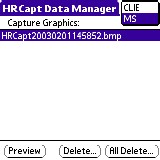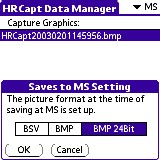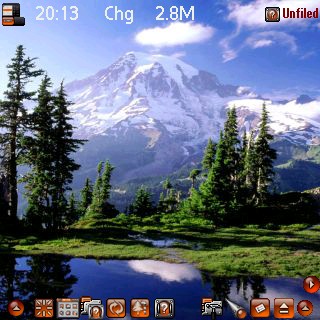
HR Capture 1.77
HRCapture is a Desk Accessory (DA) does just that, captures your CLIE screen
to a bitmap on your handheld. It comes in two parts: the DA (HRCaptDA) and a data manager (HRCaptDM) that acts
as a view and configuration program on the handheld.
HRCapture does not operate as a stand-alone application. It requires a DA Launcher like Tatsushi Yamada's DA
Launcher, or Michael J. McCollister's McPhling. I don't use
DAs, but Brain Spradlin's excellent website has a tutorial
on the required setup. Under McPhling, which I use, all you do is select HRCaptDA as a favorite so that it shows
up on the menu all the time. That makes it a piece of cake to use, and its always available at a stylus stroke.

Before you run HRCaptDA for the first time, I found it best to setup its operation from HRCaptDM. Images are bitmaps
that can be sent to RAM or the MS just by selecting the list box in the upper right of the screen.

Bitmap formats can be selected from the menu option "Saves to MS Settings..." Just tap the format desired
and then OK, and you're off to the races. There is one more setting for time delay to capture screens, which helps
capture screen menus that dismiss after any tap on the screen.
If the setup sounds simple, it is. I had this set up in less than a minute. After putting the screen I wanted to
capture up, dragging to bring up McPhling and tapping HRCaptDA, it did the rest.
Images can be examined on the device using HRCaptDM. Since the captured screens are indistinguishable from real
screens, HRCaptDM flashes a small bar across the screen reminding the user that they are looking at a captured
image. That sounds trite, but it's an incredibly handy feature and demonstrates the developers attention to detail.
The program archive also contains a Windows or Mac program (depending on the archive your choose to download) that
converts the captured .pdb files to bitmaps. The program is simple to operate. You don't need this to convert images
saved to the card, only those saved to RAM.
In doing reviews, including this one, I then copy the images to my PC using MS Import. I give them meaningful names
and possibly resize them, then use them in my reviews. I just doesn't get any easier. That's good, because the
developer is Japanese and doesn't speak or write much English. His website is also in Japanese. There is an English
text file with the basics in the archive which was probably translated using Babelfish or similar engine. My hat
is off to RA Chime for his providing an English version of the program.
I highly recommend this program to anyone that needs a screen capture utility. After all, a picture really is worth
a thousand words!
